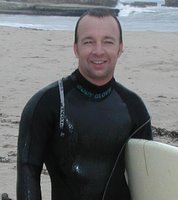Day Three
- Angela Park - from Diversity Matters had some really great points about what leadership means in light of an increasingly "diverse" public. What does that mean anyway, "diverse"? Well, Angela brought up some really interesting issues about how we perceive said diversity, what it means in terms of membership to different groups, and how best to foster it and by doing so make our organizations or agencies more effective & more resilient.
- Amber Mace - gave a great summation of her pretty impressive career, and the risks she took and methods she used to include herself in the world of coastal planning and management. Now the ED of the California Ocean Science Trust, Amber's diligence, hard work and determination obviously paid off. I managed to speak with her for quite some time during dinner one night and she recommended, both then and during her talk, the book What Color is Your Parachute. Though I haven't managed to work through all the exercises there are a lot of great ideas and principles presented behind not only finding employment, but finding a field, industry and ultimately calling, that will not only pay the bills, but also fulfill you in somewhat deeper ways.
- Meg Caldwell - had some great accounts about how being in the right place at the right time, being tenacious and sometimes not knowing enough to know better, get you where you need to be. Its clear from her experience that Meg is an amazing & accomplished woman, but what was just as impressive to me was the air of casualness, humility and honesty that she showed behind the podium.
- Michael Orbach - This man, if you are familiar w/ the world of coastal & ocean issues/planning/management etc. needs no introduction. Dr. Orbach told us about some of the experiences that led him to various corners of the world, and to multiple offices, assignments and appointments during his impressive career. The thing I think I like the most about Orbach is his ability to approach this field from the perspective of the stake-holder, of always remembering that locals are experts too (sometimes moreso) and that each and every environment comes with its own unique set of circumstances and opportunities. He's an anthropologist so this isn't too surprising, and for that I'll forgive him for using South Padre Island as his slide in asking "Is coastal management working?".
- Chad Nelsen from the Surfrider Foundation discussed his work on the economics of surfing particularly in one of California's (and the world) classic surf spots, Trestles. There has been a huge campaign to save the watershed that feeds the banks that create this wave and Chad's research at least proved that surfer's were capable of arguing for their resources on term$ better understood by developers and policy makers.
- Melissa Murphy from Oregon State University & Save the Waves Coalition took a similar approach to the wave in Mundaka, Spain which
hostshosted one of the stops on the Billabong Pro tour. Her work really illustrated how little many local communities understand what an incredible resource a world class wave is. Though the wave at Mundaka seems to be affected by a number of factors, there are definitely anthropomorphic reasons for its (now) fickle nature. - Last but certainly not least was work presented by Paola Pijoan with Surfrider Ensenada. As a mexican, a surfer, a Surfrider member and someone that realizes what a tricky issue wave resources, development and tourism in Mexico can be, I was immediately interested in the work that she is doing and her approach to trying to develop a means by which wave resources can be developed and shared equitably and sustainably. Hopefully I'll be able to visit Ensenada sometime soon and see the "issues" first hand.
Labels: Caldwell, leadership, Mace, Orbach, Park, surf economics, surfing, Surfrider, TCS 21


